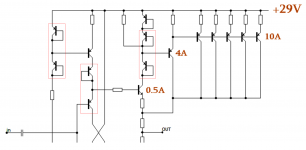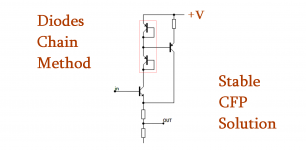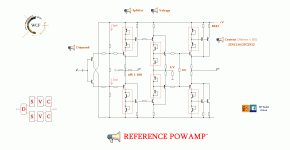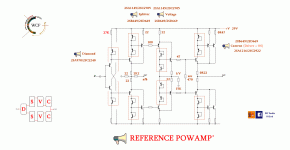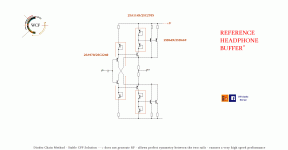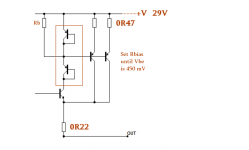Yes true
depending on the supply voltage rails
so
the diode chain is required in the presence of a voltage step
for example (see picture)
if the polarization is made with a resistor
it is NOT important to protect the base
but if it is polarized by a constant current source
Yes
understand exactly what happens in this chain
think it is indeed no easy analysis
it is intuitively easy to understand
adding an apparently useless
as in the mirror of Wilson
with 3 or 4 Parts
depending on the supply voltage rails
so
the diode chain is required in the presence of a voltage step
for example (see picture)
if the polarization is made with a resistor
it is NOT important to protect the base
but if it is polarized by a constant current source
Yes
understand exactly what happens in this chain
think it is indeed no easy analysis
it is intuitively easy to understand
adding an apparently useless
as in the mirror of Wilson
with 3 or 4 Parts
Attachments
Last edited:
Drastic misunderstanding of how a Wilson current mirror functions.
http://en.wikipedia.org/wiki/Wilson_current_mirror
A non-linear voltage divider, driving a 2/1 voltage divider, driving a
BE junction and emitter resistor. And I can't even follow a purposely
curved or distorted logic to it after that. This certainly does not appear
to be a linear mirror of anything.
Put down the iron and step away from the fumes...
http://en.wikipedia.org/wiki/Wilson_current_mirror
A non-linear voltage divider, driving a 2/1 voltage divider, driving a
BE junction and emitter resistor. And I can't even follow a purposely
curved or distorted logic to it after that. This certainly does not appear
to be a linear mirror of anything.
Put down the iron and step away from the fumes...
Last edited:
Hi,
simmed the circuit from #15 with the only difference of replacing the output Transistors Q7/Q8 by the complementary 2SA1216/2SC2922 pair.
And compared it to the same circuit without the two diodes D2 and D3.
The only noteable and expectable difference was the roundabout 0.6V voltage drop over D2 and D3.
Amplitude response, THD level and spectrum and noise are virtually identical.
Rather the circuit without the diodes beeing ahead by a Yota.
Response to a rectangle signal is rather defined by the value of the compensation caps C1 and C2.
Removing the Caps C1 and C2 leads to damped ringing, but again both circuits behaving identical.
The absence of D2 and D3 doesn´t change anything.
So far none of he claims could be verified in simulation.
And so far no sensible technical explanation has been provided.
As long as not someone steps up with a sensible explanation, to me the "diode chain" looks like ´Money for nothing´.
jauu
Calvin
simmed the circuit from #15 with the only difference of replacing the output Transistors Q7/Q8 by the complementary 2SA1216/2SC2922 pair.
And compared it to the same circuit without the two diodes D2 and D3.
The only noteable and expectable difference was the roundabout 0.6V voltage drop over D2 and D3.
Amplitude response, THD level and spectrum and noise are virtually identical.
Rather the circuit without the diodes beeing ahead by a Yota.
Response to a rectangle signal is rather defined by the value of the compensation caps C1 and C2.
Removing the Caps C1 and C2 leads to damped ringing, but again both circuits behaving identical.
The absence of D2 and D3 doesn´t change anything.
So far none of he claims could be verified in simulation.
And so far no sensible technical explanation has been provided.
As long as not someone steps up with a sensible explanation, to me the "diode chain" looks like ´Money for nothing´.
jauu
Calvin
Last edited:
How it works is very important, as it forms part of the case for assessing whether it works. We are not convinced that it does work, and you have not offered any evidence.Stee said:how it works it's not important
How it works is very important, as it forms part of the case for assessing whether it works. We are not convinced that it does work, and you have not offered any evidence.
...Exactly like every single claim from the same author so far. Unlike religion, revelation does not work for electronics. I really don't understand why anyone bothers commenting?
That is true. That is why I don't accept 'proof by assertion', especially when it is fairly obvious that the thing claimed is untrue.Stee said:Scientists are you
definition of a phenomenon undetermined
means that the phenomenon is the object as such
even if the result of an empirical intuition
it is fairly obvious that the thing claimed is untrue.
Heuristic - Wikipedia, the free encyclopedia
means that the phenomenon is the object as such
even if the result of an empirical intuition
it is fairly obvious that the thing claimed is untrue.
Heuristic - Wikipedia, the free encyclopedia
Is this some obscure form of Italian poetry?Stee said:definition of a phenomenon undetermined
means that the phenomenon is the object as such
even if the result of an empirical intuition
this connection achieves speed, stability
and above all, absolute equality of gain (unit gain)
between the two rails
Everything in class B? That's good??
Still class B on the output stage. Set the emitter resistor value and calculate the bias current assuming all Vbe's and diode drops are equal.
What's the voltage drop across the output emitter resistors?
Jan
What's the voltage drop across the output emitter resistors?
Jan
Yes true
still class AB on final devices
the voltage across output emitter resistor I think around 50mV for medium size
150mV for big size and need dissipators
still class AB on final devices
the voltage across output emitter resistor I think around 50mV for medium size
150mV for big size and need dissipators
...Exactly like every single claim from the same author so far. Unlike religion, revelation does not work for electronics. I really don't understand why anyone bothers commenting?
Because his "circuits" are often, if not always, quite unfamiliar...😉
Where does the current through that extra resistor flow to? (Hint: it does NOTHING for Vbe).
Jan
Jan
- Status
- Not open for further replies.
- Home
- Amplifiers
- Solid State
- cfp - variant --> current coupled
